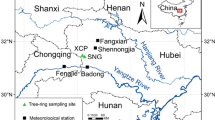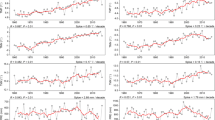Abstract
Horqin Sandy Land, a region in China that suffers from desertification, has become a primary economic zone in Inner Mongolia MengDong. Ecological and environmental problems continue to affect the local environment and human survival, becoming one of the bottlenecks to economic and social development. Thus, research on the characteristics of climatic variation is urgently required. This study used the comprehensive timeline for the regional tree wheel width of Horqin Sandy Land to reconstruct the average minimum winter temperatures of the study area. The timeline, which has been in use for 183 years, was established using core samples from the annual growth rings of elm trees in 10 sampling sites. For 181 years (1826–2006), varying minimum temperatures were observed: a gentle wave stage (1826–1923), an intense cooling stage (1923–1957), and a considerable heating stage (1957–2006). The longest continuous heating stage was observed from 1957 to 2006, during which time the average minimum temperature was −16.81 °C, a value greater than the mean temperature over the entire study period. The coldest 10 years occurred during the 1950s, until 1957, at which point the temperature sharply increased. The next 50 years exhibited a general warming trend until 2000. This period reflected a time span with the warmest minimum temperature and displayed a warming trend rate of 0.575 °C/10 years and an overall increase of up to 1.5° every 50 years. A continued rise in temperature is predicted to cause a wider range and longer time scale of ecological and environmental problems.







Similar content being viewed by others
References
Cook ER, Jacoby GC (1983) Potomac river stream flow since 1730 as reconstruction tree rings. J Clim Appl Meteorol 22:1659–1672
Chen LX, Zhou XJ, Li WL, Luo YF, Zhu WQ (2004) Characteristics of the climate change and its formation mechanism in China in last 80 years. Acta Meteorol Sin 62(5):634–646
Ding YH, Ren GY, Shi GY, Gong P, Zheng XH, Qu PM, Zhang DE, Zhao ZC, Wang SW, Wang HJ, Luo Y, Chen DL, Gao XJ, Dai XS (2006) National assessment report of climate change (I): climate change in China and its future trend. Adv Clim Chang Res 2(1):3–8
Dong GR, Jin HL, Chen HZ, Zhang CL (1998) China northern half dry and subhumid regions of the cause of desertification. Quat Sci 2:136–144
Esper J, Cook ED, Schweingruber FH et al (2003) Test of the RCS met hod for preserving low-frequency variability in long tree-ring chronologies. Tree-Ring Res 9(2):81–98
Fritts HC (1976) Tree ring and climate. Academic, London, pp 1–500
Giovanna B, David F et al (2010) Five centuries of Central European temperature extremes reconstructed from tree-ring density and documentary evidence. Glob Planet Chang 72:182–191
Hou YL, Li DL, Shi YF, Shen YP (2006) Variation of annual mean temperature in northeast of China and its responding to the northern hemisphere warming and snow cover area changing in Eurasia. J Glaciol Geocryol 28(6):900–908
Jiang DM, Liu ZM, Cao YC et al (2003) Study on desertification and its restoration of Keerqin sandy land. China environmental science press, Beijing, pp 32–39
Karl T, Jones P, Knight R et al (1993) A new perspective on recent global warming: asymmetric trends of daily maximum and mini-mum temperature. Bull Am Meteorol Soc 74(6):1007–1023
Law BE, Turner D, Lefsky M et al (2006) Carbon fluxes across regions: observational constraints at multiple scales. In: Wu J, Jones B, Li H et al (eds) Scaling and uncertainty analysis in ecology: methods and applications. Columbia University Press, New York, pp 167–190
Li AM, Han ZW, Huang CH, Tan ZH (2007) Remote sensing monitoring on dynamic of sandy desertification degree in Horqin Sandy Land at the beginning of 21st century. J Desert Res 27(4):546–551
Li JF, Yuan YJ, You XR et al (2000) Tree-ring research and application of hydrology. China environmental science press, Beijing, pp 106–107
Liang CP, Xin GD, Wang AZ, Jin CJ, Yuan FH, Wu JB, Ni P (2009) Characteristics of climate change in Horqin Sandy Land in past 56 years. Chin J ecol 28(1):2326–2332
Ma L, Liu TX, Ji HL, Luo YY, Duan LM, Yang Y (2011) Establishment of ring width chronology and reconstruction of Ulmus pumila L.in Horqin Sandy Land since 1826. Quat Sci 31(2):360–369
Ma L, Liu TX, Kou ZQ, Kang CF (2007) Relationship of elm growth and hydrometeorological factors of Horqin Sandy Land and climatic series reconstruction. J Glaciol Geocryol 29(5):802–807
Ma XB (1999) Asymmetric trend of maximum and mini-mum temperature change in northwest China. J Meteorol 57(5):613–621
Magda VN, Zelenova AV, Andreev SG (2001) A 280-year reconstruc-tion of Baikal Lake water level from treerings. Confercnce “Tree Rings and Peopl” 22–26
Nicoletta M (2004) Climate from dendrochronology: latest developments and results. Glob Planet Chang 40:129–139
Shao XM (1997) Some development of chronology round the tree. Quat Sci 3:265–271
Shao XM, Wang SZ, Xu Y, Zhu HF, Xu XG, Xiao YM (2007) A 3500-year master tree-ring dating chronology from the northeastern part of the Qaidam Basin. Quat Sci 27(4):477–485
Stockton CW, Meko DM (1975) A long-term history of drought occurrence in western United States as inferred from tree rings. Weatherwise 28(6):245–249
Sun FH, Yang XQ, Lu S, Yang SY (2006) The contrast analysis on the average and extremum temperature trend in northeast china. Sci Meteorol Sin 26(2):157–163
Van Arsdale RB, Stahle DW, Cleaveland MK (1998) Earthquake signals in tree-ring data from the New Madrid seismic zone and implications for paleoseimicity. Geology 26(6):515–518
Wang SW (1994) Introduction to the climate system. China meteorological press, Beijing, pp 54–59
Wang T, Zhu ZD (2001) The desertification problems of northern China. Quat Sci 21(1):56–65
Wang HM, Luo YM, Jiang DM (2007a) Unsymmetrical variation of the maximum and minimum air temperatures in Wengniute Banner, Horqin Sandland. Arid Zone Res 24(2):261–267
Wang HM, Luo YM, Jiang DM (2007b) Variation trends of maximal and minimal air temperature at Wulanaodu region, Horqin steppe. Chin J Agrometeorology 28(2):124–127
Wang L, Xie XQ, Su W, Guo XB (2004a) Changes of maximum and minimum temperature and their impacts in northern China over the second half of the 20th century. J Nat Resour 19(3):337–343
Wang SW, Luo Y, Zhao ZC, Dong WJ, Yang B (2005) The dispute about climate change. Prog Nat Sci 15(8):917–922
Wang T, Chen GT, Zhao HL, Dong ZB, Zhang XY, Zheng XJ, Wang NA (2006) Research progress on aeolian desertification process and controlling in north of China. J Desert Res 26(4):507–516
Wang T, Wu W, Xue X, Sun QW, Zhang WM, Han ZW (2004b) Spatial-temporal changes of sandy desertified land during last 5 decades in northern China. Acta Geogr Sin 59(2):203–212
Wang T, Wu W, Zhao HL, Hu MC, Zhao AG (2004c) Analyses on driving factors to sandy desertification process in Horqin Region, China. J Desert Res 24(5):519–528
Wang T, Zhu ZD, Wu W (2002) Sandy desertification in the north China. Sci China Ser D 45(Supp):23–34
Wilson R, Luckman B (2003) Dendroclimatic reconstruction of maximum summer temperatures from upper treeline sites in interior British Columbia. Canada. The Holocene 13(6):851–861
Wu XD, Sun L, Zhan XZ (1989) Attempt on past climate change of central Tibet under the method of tree ring material reconstruction. Acta Geograph Sin 44(3):334–341
Xie Z, Cao HX (1996) Asymmetric trend of maximum and minimum temperature change in Beijing. J Meteorol 54(4):501–507
Xun LC, Zhou XJ, Li WL (2004) Characteristics of the climate change and its formation mechanism in china in last 80 years. Acta Geogr Sin 62(5):634–646
Yi SW, Lu HY, Zhou LY, Miao XD (2006) The wet-dry variations of the Horqin sandy field recorded by loess deposit of the late quaternare. J Desert Res 26(6):869–874
Zhai PM, Pan XH (2003) Changes on temperature and precipitation extreme events in northern china over nearly 50 years. J Geogr Sci 58(Supp):408–414
Zhang YC, Zhang LJ (2005) Precipitation and temperature probability characteristics in climatic and ecological transition zone of northeast China in recent 50 years. Sci Geogr Sin 25(5):561–566
Zhao HL, Da HJZ, Zhou RL, Li YL, Zuo XA, Huang G (2008) Effects of human activity and climate changes on vegetation in Horqin sandy grassland, inner Mongolia. Adv Earth Sci 23(4):408–414
Zhuo ZD, Hu SX, Zhang XG, Zhao Q, Wang YX, Liu GY (1979) Tree ring in the Qilian mountains and climate change of nearly one thousand years in china (1059–1975). J Lanzhou Univ 2:145–157
Acknowledgments
This research was supported by the Inner Mongolia Autonomous Region Innovation team on water resources efficiency of semi-arid regions affected by hydrological processes and its regulation technology, Inner Mongolia Natural Science Fund Projects (Grant No: 2014MS0407, 2010BS0608), and the National Natural Science Funds Projects (Grant No: 50869005).
Author information
Authors and Affiliations
Corresponding author
Rights and permissions
About this article
Cite this article
Ma, L., Liu, T., Wang, J. et al. Determining changes in the average minimum winter temperature of Horqin Sandy Land using tree ring records. Theor Appl Climatol 123, 703–710 (2016). https://doi.org/10.1007/s00704-015-1382-5
Received:
Accepted:
Published:
Issue Date:
DOI: https://doi.org/10.1007/s00704-015-1382-5




